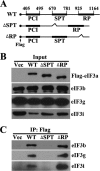Spectrin domain of eukaryotic initiation factor 3a is the docking site for formation of the a:b:i:g subcomplex
- PMID: 23921387
- PMCID: PMC3784709
- DOI: 10.1074/jbc.M113.483164
Spectrin domain of eukaryotic initiation factor 3a is the docking site for formation of the a:b:i:g subcomplex
Abstract
eIF3a (eukaryotic translation initiation factor 3a), one of the core subunits of the eIF3 complex, has been implicated in regulating translation of different mRNAs and in tumorigenesis. A subcomplex consisting of eIF3a, eIF3b, eIF3g, and eIF3i (eIF3(a:b:i:g)) has also been identified. However, how eIF3a participates in translational regulation and in formation of the eIF3(a:b:i:g) subcomplex remain to be solved. In this study, we used the tandem affinity purification approach in combination with tandem MS/MS and identified the spectrin domain of eIF3a as the docking site for the formation of eIF3(a:b:i:g) subcomplex. Although eIF3b and eIF3i bind concurrently to the spectrin domain of eIF3a within ∼10-15 amino acids apart, eIF3g binds to eIF3a indirectly via binding to the carboxyl-terminal domain of eIF3b. The binding of eIF3b to the spectrin domain of eIF3a occurs in its RNA recognition motif domain where eIF3j also binds in a mutually exclusive manner. Together, we conclude that the spectrin domain of eIF3a is responsible for the formation of eIF3(a:b:i:g) subcomplex and, because of mutually exclusive nature of bindings of eIF3a and eIF3j to eIF3b, different subcomplexes of eIF3 likely exist and may perform noncanonical functions in translational regulation.
Keywords: Mass Spectrometry (MS); Protein-protein Interactions; Proteomics; TAP Purification; Translation Control; Translation Initiation Factors.
Figures









Similar articles
-
Structure of eIF3b RNA recognition motif and its interaction with eIF3j: structural insights into the recruitment of eIF3b to the 40 S ribosomal subunit.J Biol Chem. 2007 Mar 16;282(11):8165-74. doi: 10.1074/jbc.M610860200. Epub 2006 Dec 26. J Biol Chem. 2007. PMID: 17190833
-
Crystal structure of the RNA recognition motif of yeast translation initiation factor eIF3b reveals differences to human eIF3b.PLoS One. 2010 Sep 16;5(9):e12784. doi: 10.1371/journal.pone.0012784. PLoS One. 2010. PMID: 20862284 Free PMC article.
-
The C-terminal region of eukaryotic translation initiation factor 3a (eIF3a) promotes mRNA recruitment, scanning, and, together with eIF3j and the eIF3b RNA recognition motif, selection of AUG start codons.Mol Cell Biol. 2010 Sep;30(18):4415-34. doi: 10.1128/MCB.00280-10. Epub 2010 Jun 28. Mol Cell Biol. 2010. PMID: 20584985 Free PMC article.
-
The translational regulator eIF3a: the tricky eIF3 subunit!Biochim Biophys Acta. 2010 Dec;1806(2):275-86. doi: 10.1016/j.bbcan.2010.07.005. Epub 2010 Jul 17. Biochim Biophys Acta. 2010. PMID: 20647036 Review.
-
eIF3a: A new anticancer drug target in the eIF family.Cancer Lett. 2018 Jan 1;412:81-87. doi: 10.1016/j.canlet.2017.09.055. Epub 2017 Oct 12. Cancer Lett. 2018. PMID: 29031564 Review.
Cited by
-
Human eIF3b and eIF3a serve as the nucleation core for the assembly of eIF3 into two interconnected modules: the yeast-like core and the octamer.Nucleic Acids Res. 2016 Dec 15;44(22):10772-10788. doi: 10.1093/nar/gkw972. Epub 2016 Oct 19. Nucleic Acids Res. 2016. PMID: 27924037 Free PMC article.
-
The eIF3 complex of Trypanosoma brucei: composition conservation does not imply the conservation of structural assembly and subunits function.RNA. 2017 Mar;23(3):333-345. doi: 10.1261/rna.058651.116. Epub 2016 Dec 8. RNA. 2017. PMID: 27932584 Free PMC article.
-
Eukaryotic initiation factor 4F promotes a reorientation of eukaryotic initiation factor 3 binding on the 5' and the 3' UTRs of barley yellow dwarf virus mRNA.Nucleic Acids Res. 2022 May 20;50(9):4988-4999. doi: 10.1093/nar/gkac284. Nucleic Acids Res. 2022. PMID: 35446425 Free PMC article.
-
Conformational Differences between Open and Closed States of the Eukaryotic Translation Initiation Complex.Mol Cell. 2015 Aug 6;59(3):399-412. doi: 10.1016/j.molcel.2015.06.033. Epub 2015 Jul 23. Mol Cell. 2015. PMID: 26212456 Free PMC article.
-
A structural inventory of native ribosomal ABCE1-43S pre-initiation complexes.EMBO J. 2021 Jan 4;40(1):e105179. doi: 10.15252/embj.2020105179. Epub 2020 Dec 8. EMBO J. 2021. PMID: 33289941 Free PMC article.
References
-
- Pestova T. V., Lorsch J. R., Hellen C. U. (2007) The mechanism of translation initiation in eukaryotes in Translational Control in Biology and Medicine (Mathews M. B., Sonenberg N., Hershey J. W., eds) pp 87–128, Cold Spring Harbor Laboratory Press, Cold Spring Harbor, New York
-
- Dong Z., Zhang J. T. (2006) Initiation factor eIF3 and regulation of mRNA translation, cell growth, and cancer. Crit. Rev. Oncol. Hematol. 59, 169–180 - PubMed
-
- Yin J. Y., Dong Z., Liu Z. Q., Zhang J. T. (2011) Translational control gone awry: a new mechanism of tumorigenesis and novel targets of cancer treatments. Biosci. Rep. 31, 1–15 - PubMed
-
- Sun C., Todorovic A., Querol-Audí J., Bai Y., Villa N., Snyder M., Ashchyan J., Lewis C. S., Hartland A., Gradia S., Fraser C. S., Doudna J. A., Nogales E., Cate J. H. (2011) Functional reconstitution of human eukaryotic translation initiation factor 3 (eIF3). Proc. Natl. Acad. Sci. U.S.A. 108, 20473–20478 - PMC - PubMed
Publication types
MeSH terms
Substances
Grants and funding
LinkOut - more resources
Full Text Sources
Other Literature Sources
Miscellaneous

